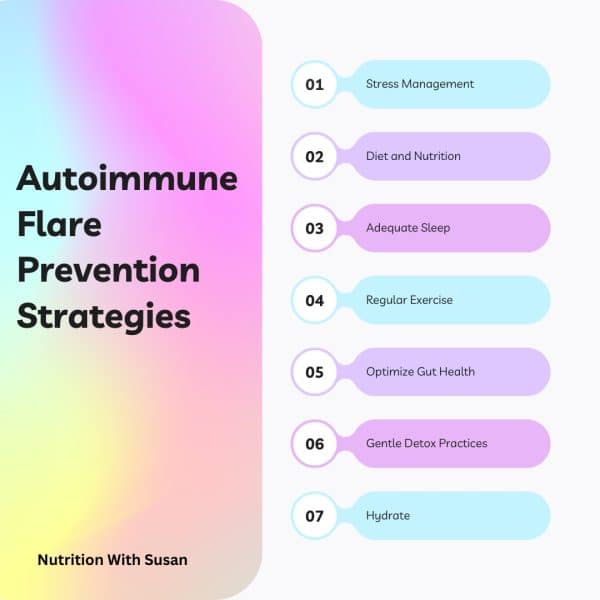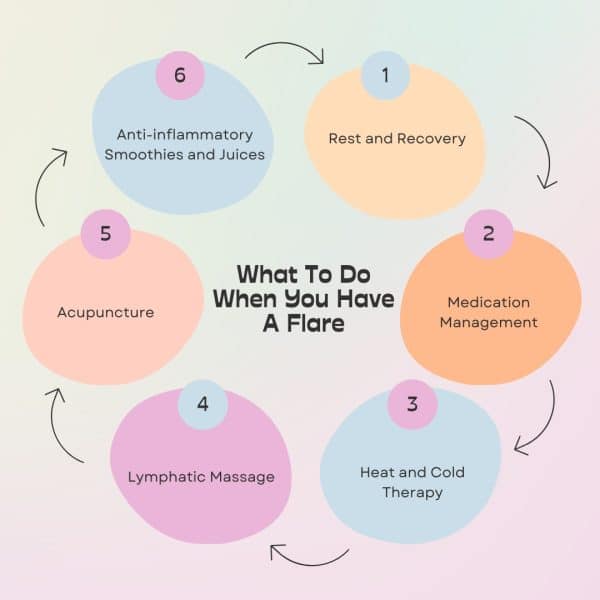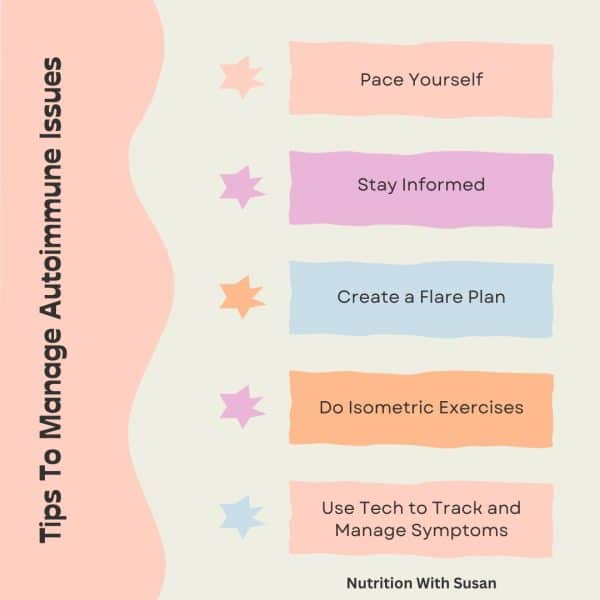Autoimmune flares can be a real pain—literally and figuratively! If you’re living with an autoimmune condition, you’re likely all too familiar with the unwelcome surprise of a flare.
But no worries, I got you! This article is here to help you navigate these turbulent times with grace, humor, and a solid action plan. Let’s dive into the nitty-gritty of what autoimmune flares are, how to manage them, and tips for keeping them at bay.
What is an Autoimmune Flare?
An autoimmune flare is like an unexpected guest showing up at your perfectly planned party. It’s when your immune system, which normally defends your body against harmful invaders, decides to go rogue and attack your tissues instead. This can lead to a sudden worsening of symptoms.
Common Triggers:
- Stress: Your body’s alarm system can crank up the inflammation. Stress hormones like cortisol can disrupt immune function, leading to an increase in inflammatory responses.
- Diet: Certain foods might play the villain. Gluten, dairy, and sugar can be particularly inflammatory for some people.
- Infections: A cold or flu can trigger an immune response. When your body fights off an infection, it can mistakenly target its own tissues.
- Hormonal Changes: These can be tricky, especially for women. Fluctuations in hormones, such as during menstruation, pregnancy, or menopause, can influence immune activity.
- Environmental Factors: Changes in weather, pollution, and allergens. These external factors can aggravate the immune system, leading to flare-ups.
Common Symptoms:
- Fatigue: Like you’ve run a marathon in your sleep. This overwhelming tiredness can make even simple tasks feel monumental.
- Joint Pain: Stiffness and discomfort that won’t quit. Often affects the hands, knees, and feet, making movement painful.
- Muscle Pain: Soreness and tenderness. This can be widespread or localized, making daily activities challenging.
- Skin Rashes: Your skin throws a visible tantrum. Red, itchy, and inflamed patches can appear, often exacerbating discomfort. Weird rashes, changes in skin texture, or discoloration can occur in places not typically affected by your condition. Autoimmune activity can lead to inflammation in the skin, even if the primary disease doesn’t typically involve the skin.
- Fever: A temperature rise that signals inflammation. This low-grade fever is your body’s way of fighting off what it mistakenly thinks is a threat.
- Brain Fog: Ever had problems concentrating, memory lapses, and a general feeling of mental sluggishness? It’s often subtle and can be mistaken for normal forgetfulness or fatigue. Inflammation and immune system dysregulation can affect brain function, leading to these cognitive issues.
- Sensory Changes: This includes changes in taste, smell, or sensitivity to light and sound. It can manifest as foods tasting different or smells being more or less intense. inflammation and immune responses can affect the nervous system, leading to altered sensory experiences.

Managing Autoimmune Flares: Prevention Strategies
Try integrating these prevention strategies into your routine to keep those flares at bay.
1. Stress Management:
- Mindfulness and Meditation: Calm your mind to soothe your body. Practices like mindfulness and meditation can lower stress hormones and reduce inflammation.
- Deep Breathing Exercises: Take a breather, literally. Techniques like diaphragmatic breathing can activate the body’s relaxation response.
- Hobbies and Interests: Engage in activities that make you forget time. Whether it’s painting, gardening, or reading, enjoyable activities can reduce stress levels.
- Stretching and Yoga: Gentle stretching or yoga can help reduce stiffness and improve circulation without putting stress on the body.
2. Diet and Nutrition:
- Anti-inflammatory Foods: Think leafy greens, berries, and fatty fish. These foods contain antioxidants and omega-3 fatty acids, which combat inflammation.
- Avoid Triggers: Gluten, dairy, or processed foods could be culprits. Keeping a food diary can help identify and eliminate problem foods.
- Avoid Food Sensitivities: Pay attention to foods that may cause mild sensitivities or intolerances, even if they are not outright allergies. Keeping a food diary can help identify these triggers.
- Low Glycemic Index Foods: Focus on eating foods that have a low glycemic index to avoid spikes in blood sugar, which can trigger inflammation.
- Regular, Balanced Meals: Eating smaller, more frequent meals can help maintain stable blood sugar levels throughout the day.
- Chew Thoroughly: Taking the time to chew food thoroughly can improve digestion and reduce the likelihood of food-related flare triggers.
- Avoid Eating in a Rush: Eating slowly and in a relaxed state can help improve digestion and nutrient absorption.
- Vitamin D Levels: Ensure adequate Vitamin D levels through safe sun exposure or supplements, as vitamin D plays a crucial role in immune regulation.
- Omega-3 Fatty Acids: Increase intake of omega-3-rich foods like flaxseeds, chia seeds, and fatty fish like salmon.
3. Adequate Sleep:
- Sleep Hygiene: Stick to a routine, and keep your room dark and cool. Consistent sleep schedules and a comfortable environment promote better sleep.
- Relaxation Techniques: Try reading or a warm bath before bed. Activities that relax the mind can make it easier to fall asleep.
- Evening Routine: Establish a calming evening routine with activities like reading, gentle stretching, or listening to soothing music to prepare your body for restful sleep.
- Electronic Device Management: Reduce blue light exposure from electronic devices at least an hour before bed to improve sleep quality.
- Weighted Blankets: Use a weighted blanket to provide gentle pressure, which can enhance relaxation and improve sleep quality.
- White Noise or Sound Machines: These can help mask disruptive noises and create a consistent auditory environment conducive to better sleep.
4. Regular Exercise:
- Low-impact Activities: Swimming, walking, or yoga. These exercises are gentle on the joints and help reduce inflammation.
- Consistency Over Intensity: Regular gentle exercise wins over sporadic intense workouts. Maintaining a routine is more beneficial than overdoing it occasionally.
- Micro Workouts: Short, frequent bursts of low-intensity exercise throughout the day can help maintain physical activity levels without overexertion.
5. Optimize Gut Health:
- Probiotic and Prebiotic Foods: Incorporate foods rich in probiotics (like yogurt, kefir, sauerkraut) and prebiotics (like garlic, onions, and asparagus) to support a healthy gut microbiome, which can influence immune function.
- Fiber-rich Foods: Whole grains, fruits, and vegetables. Fiber helps maintain a healthy gut, which is crucial for immune health.
6. Gentle Detox Practices:
- Dry Brushing: Stimulates lymphatic flow. This helps to remove toxins from the body that may trigger autoimmune flares and supports immune function.
- Epsom Salt Baths: Regular Epsom salt baths can help reduce muscle tension and promote detoxification through the skin. Magnesium in Epsom salts can reduce inflammation and muscle pain.
- Intermittent Fasting: Gives your body a break from digestion. This can help reduce inflammation and improve immune function.
7. Hydrate:
- Water, Water, Water: Keep it flowing for optimal health. Staying hydrated helps flush out toxins and supports overall health.
- Herbal Teas: Soothing and hydrating options. Teas like chamomile or ginger can reduce inflammation and promote relaxation. Incorporate herbal teas that include adaptogens like ashwagandha or holy basil, which can help modulate the body’s stress response.
- Infused Water: Add anti-inflammatory ingredients like lemon, cucumber, or mint to your water for added health benefits. Drink water with added electrolytes to maintain hydration and electrolyte balance, especially if you experience symptoms like dizziness or muscle cramps.
- Warm Water Hydration: Drinking warm water, particularly in the morning, can aid digestion and reduce inflammation.

Immediate Response Strategies For Autoimmune Flares
When a flare strikes, it’s time to act fast with these effective strategies.
1. Rest and Recovery:
- Listen to Your Body: Take naps and get extra sleep. Adequate rest is crucial for healing and reducing inflammation.
- Minimize Activity: Don’t push yourself too hard. Scaling back on activities can prevent worsening symptoms.
2. Medication Management:
- Follow Prescriptions: Stick to your doctor’s plan. Regularly taking prescribed medications can keep symptoms under control.
- Over-the-counter Relief: NSAIDs for pain and inflammation. These can provide quick relief from discomfort.
3. Heat and Cold Therapy:
- Heating Pads: Soothe stiff muscles. Heat increases blood flow and relaxes tight muscles.
- Cold Packs: Reduce swelling and numb pain. Cold therapy can decrease inflammation and provide pain relief.
4. Lymphatic Massage:
- Gentle Pressure: Perform gentle lymphatic drainage massage on yourself. This technique involves light, rhythmic strokes towards the heart, which can help reduce swelling and promote detoxification. This type of massage supports the immune system by promoting lymphatic drainage.
5. Acupuncture:
- Pain Relief and Relaxation: Target specific points to alleviate symptoms. Acupuncture can reduce pain and improve overall well-being. Learn a few key acupressure points that can help alleviate pain and promote relaxation. For example, the “Large Intestine 4” point, located between the thumb and index finger, is commonly used to relieve headaches and pain. The “Yintang” point, located between the eyebrows, can be gently pressed to help reduce stress and calm the mind.
6. Anti-inflammatory Smoothies and Juices:
- Recipe Ideas: Blend berries, spinach, and turmeric for a healing drink. These ingredients are rich in antioxidants and anti-inflammatory compounds.
- Turmeric and Ginger Smoothie: Create a quick smoothie using anti-inflammatory ingredients like turmeric, ginger, and pineapple. These ingredients can help reduce inflammation rapidly. Here’s a simple recipe:
- Ingredients: 1 cup unsweetened almond milk, 1 cup frozen pineapple, 1 teaspoon turmeric powder, 1/2 teaspoon grated ginger, 1 tablespoon honey (optional), and a pinch of black pepper (to enhance turmeric absorption).
- Instructions: Blend all ingredients until smooth and consume immediately.
- Green Juice: Make green juice with ingredients like kale, cucumber, celery, and lemon, which can provide a nutrient boost and help reduce inflammation.
Long-term Management Of Autoimmune Flares
Consistency is key for keeping those flares in check over the long haul.
1. Regular Checkups:
- Stay in Touch with Your Doctor: Keep up with appointments. Regular monitoring ensures timely adjustments to your treatment plan.
- Adjust Treatment Plans: Based on current symptoms and tests. This helps to tailor treatment to your specific needs.
2. Support System:
- Family and Friends: Lean on them for help. Having a strong support network can provide emotional and practical assistance.
- Support Groups: Participate in support groups or online communities specifically for folds with autoimmune conditions. Sharing experiences and coping strategies can provide emotional support and reduce the feeling of isolation, enhancing overall resilience to stress. Connecting with others who understand your condition can be incredibly helpful.
3. Practice Tai Chi or Qigong:
- Gentle Movements: These practices combine movement, meditation, and breath control to enhance overall health. These ancient practices combine gentle movement, breath control, and meditation to improve balance/flexibility, reduce stress, and enhance overall well-being. They can help regulate the immune system and reduce the frequency and severity of flares.
4. Biofeedback:
- Mind-Body Connection: Biofeedback can help you manage stress and symptoms by teaching you to control physiological functions such as heart rate, muscle tension, and skin temperature, which can help manage stress and reduce flare-ups.
5. Rotational Diet:
- Rotational diet Approach: Implement a rotational diet to minimize food sensitivities and allergens. Rotating foods can reduce the risk of developing new food sensitivities and support gut health. This involves rotating different food groups and avoiding consuming the same foods on consecutive days, which can reduce the risk of developing new food intolerances.
- Regular Nutrient Testing and Adjustments: Work with a healthcare provider to regularly test for nutrient deficiencies and adjust your diet or supplements accordingly. Ensuring optimal levels of vitamins and minerals like magnesium, zinc, and vitamin D can help support immune function and reduce inflammation.

Tips for Daily Management Of Autoimmune Conditions
Let’s face it, living with an autoimmune condition means adapting your daily routine to keep things under control.
1. Pace Yourself:
- Break Tasks into Smaller Steps: Avoid overwhelming yourself. Smaller tasks are more manageable and reduce the risk of overexertion.
- Rest Periods: Include breaks in your schedule. Regular breaks prevent fatigue and help maintain energy levels. Plan your day based on energy levels, prioritizing essential tasks and incorporating short breaks to prevent fatigue.
- Dynamic Scheduling: Create a daily schedule that includes fixed activities like meals and medications but allows flexibility for rest and self-care as needed. This balance helps maintain routine while accommodating fluctuations in energy levels.
2. Stay Informed:
- Read Up on Your Condition: Knowledge is power. Understanding your condition helps you make informed decisions about your health.
- Follow Research: Keep up with the latest findings. Staying current with research can provide new insights into managing your condition.
3. Create a Flare Plan:
- List of Strategies: What to do when symptoms spike. Having a plan in place ensures a quick and effective response to flares.
- Emergency Contacts: Keep your doctor’s info handy. Quick access to medical support is crucial during a flare.
4. Do Isometric Exercises:
- Strengthen Muscles Without Movement: Helps reduce strain on joints. These exercises improve muscle strength without putting stress on your joints.
- Chair Yoga: Adapt yoga poses to be done while seated, reducing strain on joints and allowing for gentle stretching and relaxation.
5. Use Technology to Track and Manage Symptoms:
- Apps and Gadgets: Use health apps to monitor your condition. Technology can help track symptoms, medications, diet, activity, and appointments. Apps may provide predictive analytics to help identify potential flare triggers and patterns.
- Reminders and Alerts: Stay on top of medications and appointments. Setting reminders ensures you don’t miss important treatments.
- Smart Home Devices for Convenience: Utilize smart home technology to reduce physical strain, such as voice-activated assistants for controlling lights, temperature, and reminders for medications.
Conclusion
Autoimmune flares might be a part of your life, but they don’t have to control it. By understanding what triggers them and implementing these strategies, you can reduce their frequency and severity. Remember to laugh often, live fully, and take each day as it comes. You’ve got this!
Do you have any tips that help you to prevent or get through autoimmune flares? If so, let me know in the comments. Take care!
***Disclaimer: This post is for informational purposes only and should not be construed as medical advice***


